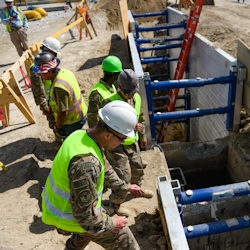Preplanning
No matter how many trenching, shoring, and backfilling jobs an employer has done in the past, it is important to approach each new job with care and preparation. Many on-the-job incidents result from inadequate initial planning.
Waiting until after the work starts to correct mistakes in sloping, shoring, or shielding slows down the operation, adds to the cost of the project, and makes a cave-in or other excavation failure more likely.
Before preparing a bid, employers should know as much as possible about the jobsite and the materials they will need to have on hand to perform the work safely and in compliance with OSHA standards. For instance, if you were bidding on a job to replace an underground utility line, you might assume that the soil covering the line would not be Type A (more on soil types in Module 3) because it is previously disturbed soil. However, you would always want to analyze the soil just to make sure.
Employers can gather the information they need through jobsite studies, observations, test borings for soil type or conditions, and consultations with local officials and utility companies. This information will help employers determine the amount, kind, and cost of safety equipment they will need to perform the work safely.
Employers should do what's necessary to avoid hitting underground utility lines and pipes during excavation work. One common industry practice is to call 811, the "Call Before You Dig" number, to establish the location of any underground utility installations in the work area.
Additional OSHA requirements employers need to follow:
- Determine the approximate location(s) of utility installations - including sewer, telephone, fuel, electric, and water lines.
- Contact and notify the utility companies or owners involved to inform them of the proposed work within established or customary local response times.
- Ask the utility companies or owners to establish the location of underground installations prior to the start of excavation work. If they cannot respond within 24 hours (unless the period required by state or local law is longer) or cannot establish the exact location of the utility installations, employers may proceed with caution, which includes using detection equipment or other acceptable means to locate utility installations.
- Determine the exact location of underground installations by safe and acceptable means when excavation operations approach the approximate location of the installations.
- Ensure that while the excavation is open, underground installations are protected, supported or removed as necessary to safeguard workers.
Knowledge Check Choose the best answer for the question.
1-4. When planning a project that involves digging a trench be sure to _____.
You forgot to answer the question!

